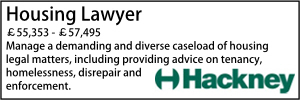Affordable housing sector demands end to "abuse" of village green laws
- Details
The laws on village greens should be overhauled to prevent “NIMBYs” blocking or delaying the building of much-needed new homes, the National Housing Federation has argued.
The NHF, which represents the affordable housing sector, said individuals fiercely opposed to any new building in their rural communities have been abusing the laws by claiming land should be reclassified as a village green and so protected from development.
Far from being at the heart of community life, the “village green” is often no more than an isolated agricultural field that has rarely attracted a single dog walker, the Federation claimed.
The NHF also argued that:
- The land in question is often privately owned, and so those claiming village green status would have been guilty of trespass if they had been using it for leisure
- The use of the tactic is hugely costly “both in monetary terms and in the time wasted in dealing with the spurious application, which stands no realistic chance of being accepted”
- It was unacceptable that local people in desperate need of an affordable house were left in limbo as a result.
The tactic adopted by opponents to housing schemes typically relies on The Enclosure Act 1957 and the Commons Act 1876, which make it a criminal offence to do anything that may injure the green or interrupt the use or enjoyment of it as a place for exercise or recreation by placing anything on the green.
Recent legislation – notably the Commons Act 2006 – has prompted a flood of village green applications, the NHF said. These changes allowed people to register open spaces as town or village greens if they prove the area has been used by local people for at least 20 years, without the permission of the landowner but without being secretive or forcing their way on to the land. Such an application can be made after planning permission has been granted.
The NHF highlighted a case in the Peak District, where plans to build 600 new affordable homes were delayed for more than two years after 20 village green applications were made. It claimed that a recent decision had cost the council £100,000 in legal advice.
The Department for Environment, Food and Rural Affairs is planning to consult this Spring on whether there is a need for reform of the town and village green registration system.
Defra's research suggested there are a wide variety of motivations for applications. “This was not necessarily the threat of housing or other building development but also a possible denial of public access or a lack of consultation over management,” its report said.
Instead, the main finding from the research was the existence of two parallel systems – the town and village green registration process and the planning system – between which there is minimal communication.
NHF chief executive David Orr said: “Village greens play an important part in community life in many villages and towns, and genuine greens need the full protection of the law. However, increasing numbers of people are submitting inappropriate village green applications in a cynical attempt to stop the building of new homes – sometimes delaying the delivery of desperately needed new housing by years and wasting millions of pounds of taxpayers' money in the process.
“We welcome the government's decision to review the village green registration process. However, it is critical that ministers move quickly to change the law so that NIMBYs are stopped from abusing the system.”
The government recently announced that plans for a comprehensive, nationwide record of town and village greens would be delayed “for at least a year”. The Parliamentary Under-Secretary of State for Environment, Food and Rural Affairs, Huw Irranca-Davies, blamed the delay on slower than expected progress with the pilot scheme involving seven local authorities.
The laws on village greens should be overhauled to prevent “NIMBYs” blocking or delaying the building of much-needed new homes, the National Housing Federation has argued.
The NHF, which represents the affordable housing sector, said individuals fiercely opposed to any new building in their rural communities have been abusing the laws by claiming land should be reclassified as a village green and so protected from development.
Far from being at the heart of community life, the “village green” is often no more than an isolated agricultural field that has rarely attracted a single dog walker, the Federation claimed.
The NHF also argued that:
- The land in question is often privately owned, and so those claiming village green status would have been guilty of trespass if they had been using it for leisure
- The use of the tactic is hugely costly “both in monetary terms and in the time wasted in dealing with the spurious application, which stands no realistic chance of being accepted”
- It was unacceptable that local people in desperate need of an affordable house were left in limbo as a result.
The tactic adopted by opponents to housing schemes typically relies on The Enclosure Act 1957 and the Commons Act 1876, which make it a criminal offence to do anything that may injure the green or interrupt the use or enjoyment of it as a place for exercise or recreation by placing anything on the green.
Recent legislation – notably the Commons Act 2006 – has prompted a flood of village green applications, the NHF said. These changes allowed people to register open spaces as town or village greens if they prove the area has been used by local people for at least 20 years, without the permission of the landowner but without being secretive or forcing their way on to the land. Such an application can be made after planning permission has been granted.
The NHF highlighted a case in the Peak District, where plans to build 600 new affordable homes were delayed for more than two years after 20 village green applications were made. It claimed that a recent decision had cost the council £100,000 in legal advice.
The Department for Environment, Food and Rural Affairs is planning to consult this Spring on whether there is a need for reform of the town and village green registration system.
Defra's research suggested there are a wide variety of motivations for applications. “This was not necessarily the threat of housing or other building development but also a possible denial of public access or a lack of consultation over management,” its report said.
Instead, the main finding from the research was the existence of two parallel systems – the town and village green registration process and the planning system – between which there is minimal communication.
NHF chief executive David Orr said: “Village greens play an important part in community life in many villages and towns, and genuine greens need the full protection of the law. However, increasing numbers of people are submitting inappropriate village green applications in a cynical attempt to stop the building of new homes – sometimes delaying the delivery of desperately needed new housing by years and wasting millions of pounds of taxpayers' money in the process.
“We welcome the government's decision to review the village green registration process. However, it is critical that ministers move quickly to change the law so that NIMBYs are stopped from abusing the system.”
The government recently announced that plans for a comprehensive, nationwide record of town and village greens would be delayed “for at least a year”. The Parliamentary Under-Secretary of State for Environment, Food and Rural Affairs, Huw Irranca-Davies, blamed the delay on slower than expected progress with the pilot scheme involving seven local authorities.
Must read
Fix it fast: How “Awaab’s Law” is forcing action in social housing
Housing management in practice: six challenges shaping the sector
Why AI must power the next wave of Social Housing delivery
Sponsored articles
Walker Morris supports Tower Hamlets Council in first known Remediation Contribution Order application issued by local authority
Unlocking legal talent
09-12-2025 1:00 pm
11-12-2025 11:00 am







































